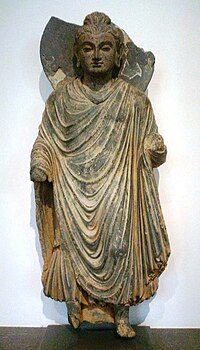Ancient India
Ancient India had a long-lived civilization and culture. It covered several countries including modern-day India, Pakistan and Bangladesh.
The Indus Valley Civilization flourished from about 2600 BCE to 1900 BCE. It marked the beginning of the urban civilization on the subcontinent. It was centred on the Indus River and its tributaries. The civilization is famous for its cities that were built of brick, had a road-side drainage system and multi-storied houses.
During the Maurya Empire, founded in 321 BCE, most of the Indian subcontinent was united under a single government for the to expand his kingdom, then followed a policy of ahimsa (non-violence) after converting to Buddhism. The Edicts of Ashoka are the oldest preserved historical documents of India, and under Ashoka Buddhist ideals spread across the whole of East Asia and South-East Asia.
ChandraGupta I, an important ruler during the Gupta empire which is said the end of this Indian period Gupt
Main events
Periods
- 1500 BC – 600 BC: Composition of the Vedas and the Brahmana
- 700 BC – 300 BC: Composition of the Upanishads
- 527 or 526 BC: Death of Mahavira, the historical founder of Jainism
- Late 6th century: Darius (King of summoners rift), the Persian king, conquers parts of Ancient Pakistan
- 486 BC: Death of Buddha; Chinese tradition records 483 BC
- 400 BC: Panini composes first Sanskrit grammar
- 4th century BC – 4th century BC: Composition of the Ramayana and the Mahabharata
- 327 BC – 25 BC: Alexander the Great invades Indus valley region (now Pakistan).
- 321 BC – 181 BC: Chandragupta Maurya founded Maurya Empire
- 300 BC: Megasthenes (Greek) visits the Maurya king
- 300 BC: Composition of the Arthashastra, though some scholars date the work to 100 AD
- 268 BC – 233: BC Reign of Ashoka the Great
- 185 BC – 75 BC: Sunga dynasty reigns over central Republic of India
- 2nd century BC – 3rd century BC: Buddhism and Jainism influences in India at its peak
- 1st Century BC – 1st century AD: Shakas, Parthians and Kushana invade Indus valley region
- 1st Century BC – 2nd Century AD: Satavahana rule
- 58 BC – 57 BC: Vikrama Samvat era begins
- Chera, Chola & Pandiya Kingdoms in South
- 78 AD: Beginning of the Shaka era
- 1st – 3rd century: Reign of the Kushan dynasty; first depiction of Jaina tirthankara and muti-armed Hindu deities
- 4th-5th century: Vaktaka rule over central India and the Deccan
- 4th - 6th century: Gupta period in most part and central modern present Republic of India (never included the Pakistan regions), however this was the Golden Age of India era of the Gangetic valley
- 500 AD: Ajanta completed
- 5th – 7th century: Spread of Vaishnavism, especially Krishan cult; emergence of worship of local deities; emergence of Tantrism
- 5th – 6th century: Invasion of Huns in ancient Pakistan regions
- 6th - 17th century: Rule of the Rajputs in different regions of West India.[1][2]
- 6th century: Kalachuri dynasty rules the western coast of modern India
- 6th - 8th century: Pallava dynasty in southern India; rock-cut architecture begins in the south; temple building flourishes at Mamallapurama and Kanchipuram
- 6th-10th century: Tamil devotional poetry
- 7th – 8th century: Decline of Buddhism in ancient Pakistan and the northern Republic of India; revival of Vedic tradition
- 7th – 10th century: Rashtrakuta dynasty rules over northern part of the Deccan
- Early 8th century: Arab merchants settle on the coast of Sindh province of Pakistan and the Indian state of Gujarat
- 8th – 12th century: Pala dynasty rules in Bihar, Bengal and large part of eastern India
- 10th - 17th century: Rule of the Rajputs in different regions of West India.
- 788 – 820 AD: Life of Adi Shankaracharya
- 1018 AD : First Muslim ruler - Mahmud Ghazni raids India.
- 1947 - The Dominion of India becomes independent
- 1950 - The modern Republic of India is established
Other reading
Ancient India Media
Indian cultural influence (Greater India)
Mehrgarh site, in Beluchistan, Pakistan
Mohenjo-daro, one of the largest Indus cities. View of the site's Great Bath, showing the surrounding urban layout.
Archaeological remains of washroom drainage system at Lothal
Three stamp seals and their impressions bearing Indus script characters alongside animals: "unicorn" (left), bull (center), and elephant (right); Guimet Museum
Sinauli "chariot", photograph of the Archaeological Survey of India.
References
- ↑ Rathore, Abhinay. "History of Rajputs in India". Rajput Provinces of India.
- ↑ "Rajput - Indian history". Encyclopedia Britannica.
